Detailed Report: Leadership, Management, and Operations at Sainsbury's
VerifiedAdded on 2020/11/23
|17
|5659
|138
Report
AI Summary
This report provides a comprehensive analysis of management and operations within Sainsbury's, a major UK supermarket chain. It explores the distinct roles and characteristics of leaders and managers, detailing their responsibilities in various operational contexts. The report examines key leadership theories, including situational and contingency models, and how these are applied to address challenges such as labor turnover, employee productivity, and interpersonal conflicts. It also highlights the importance of operational efficiency, decision-making, and factors like CSR, culture, and sustainability in shaping business operations. The report covers the functions of managers, including planning, organizing, and controlling, and the functions of leaders like setting goals and organizing teams, and the application of Henry Fayol's management theory. Overall, the report provides valuable insights into effective leadership and management practices within a large retail organization.
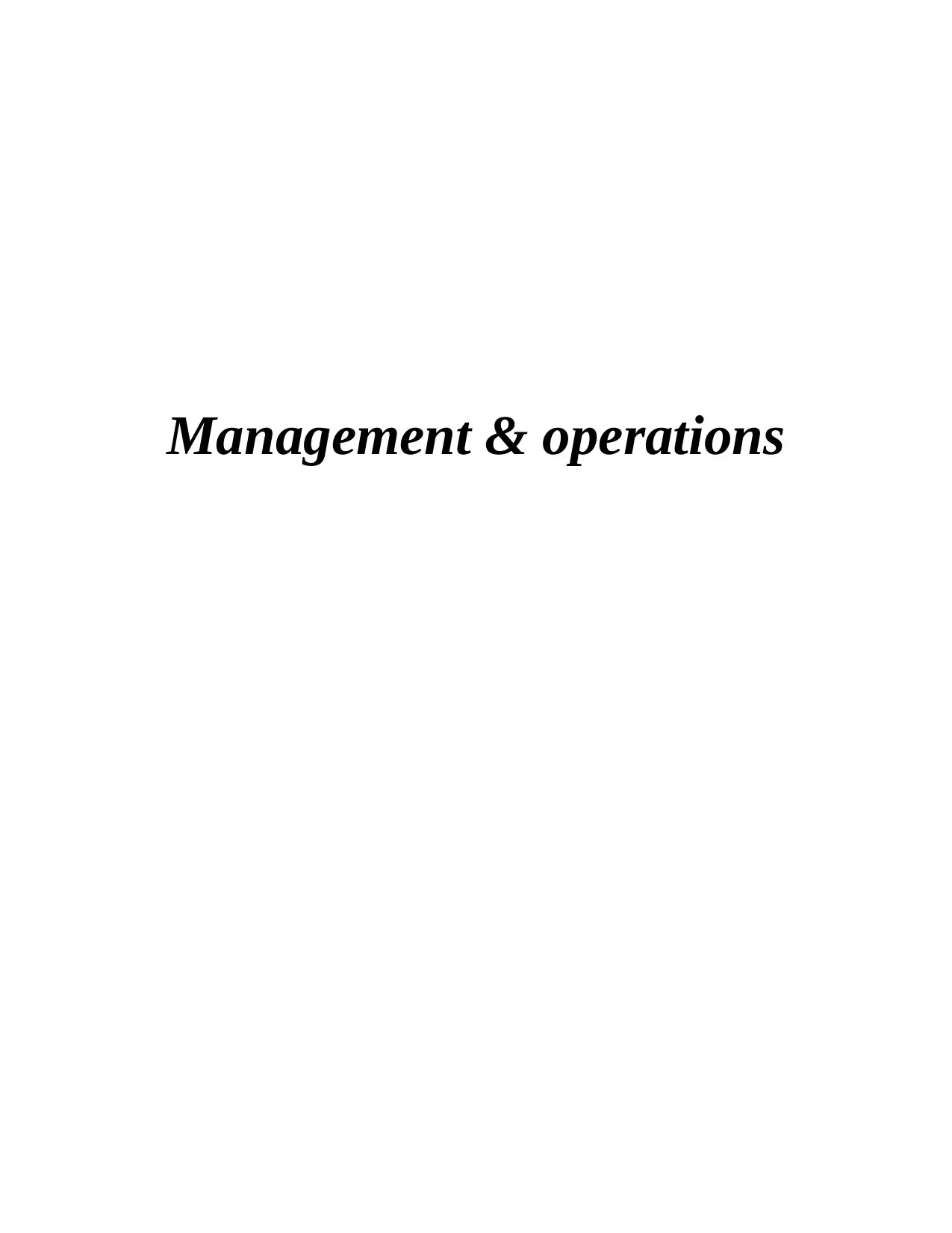
Management & operations
Paraphrase This Document
Need a fresh take? Get an instant paraphrase of this document with our AI Paraphraser
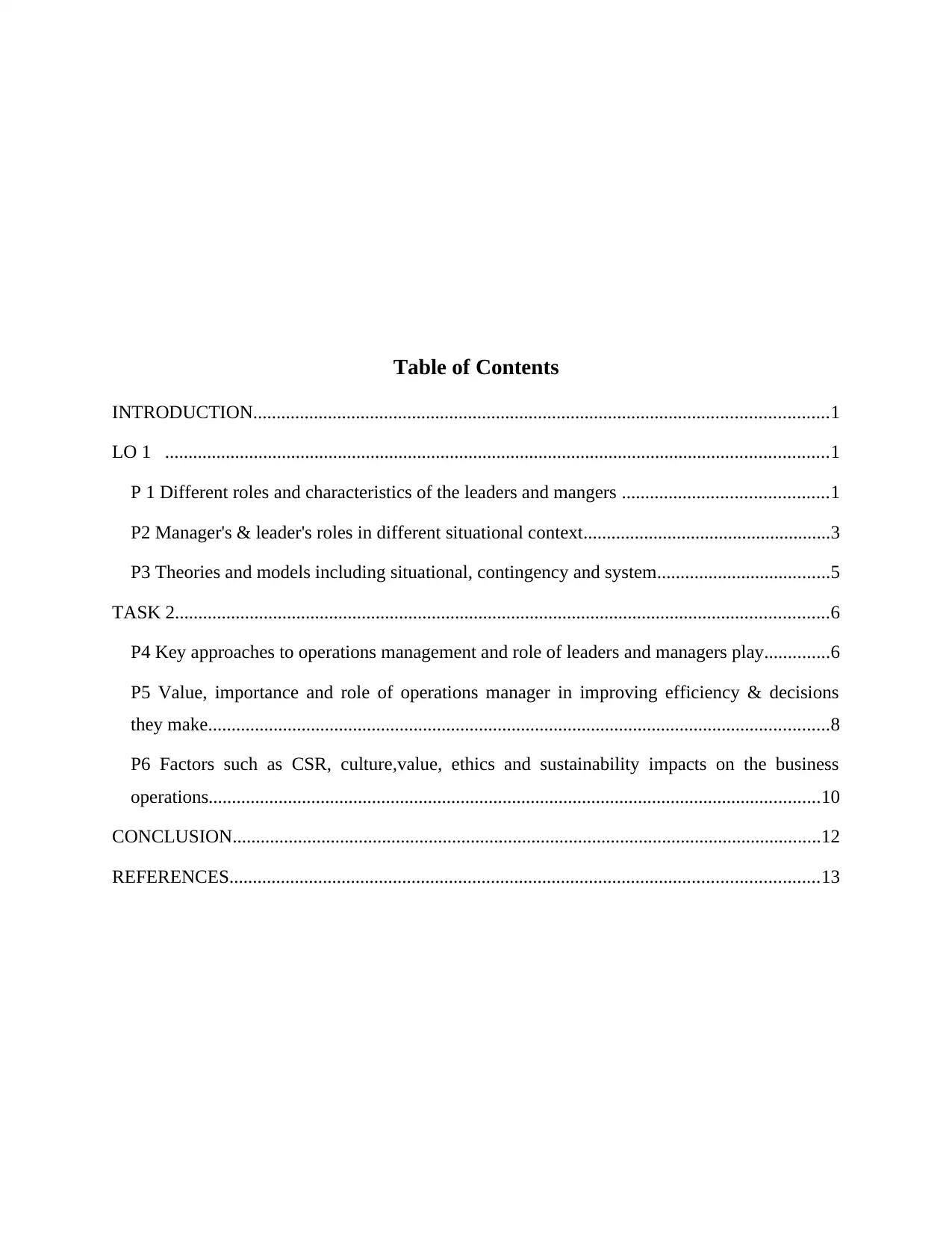
Table of Contents
INTRODUCTION...........................................................................................................................1
LO 1 ..............................................................................................................................................1
P 1 Different roles and characteristics of the leaders and mangers ............................................1
P2 Manager's & leader's roles in different situational context.....................................................3
P3 Theories and models including situational, contingency and system.....................................5
TASK 2............................................................................................................................................6
P4 Key approaches to operations management and role of leaders and managers play..............6
P5 Value, importance and role of operations manager in improving efficiency & decisions
they make.....................................................................................................................................8
P6 Factors such as CSR, culture,value, ethics and sustainability impacts on the business
operations...................................................................................................................................10
CONCLUSION..............................................................................................................................12
REFERENCES..............................................................................................................................13
INTRODUCTION...........................................................................................................................1
LO 1 ..............................................................................................................................................1
P 1 Different roles and characteristics of the leaders and mangers ............................................1
P2 Manager's & leader's roles in different situational context.....................................................3
P3 Theories and models including situational, contingency and system.....................................5
TASK 2............................................................................................................................................6
P4 Key approaches to operations management and role of leaders and managers play..............6
P5 Value, importance and role of operations manager in improving efficiency & decisions
they make.....................................................................................................................................8
P6 Factors such as CSR, culture,value, ethics and sustainability impacts on the business
operations...................................................................................................................................10
CONCLUSION..............................................................................................................................12
REFERENCES..............................................................................................................................13
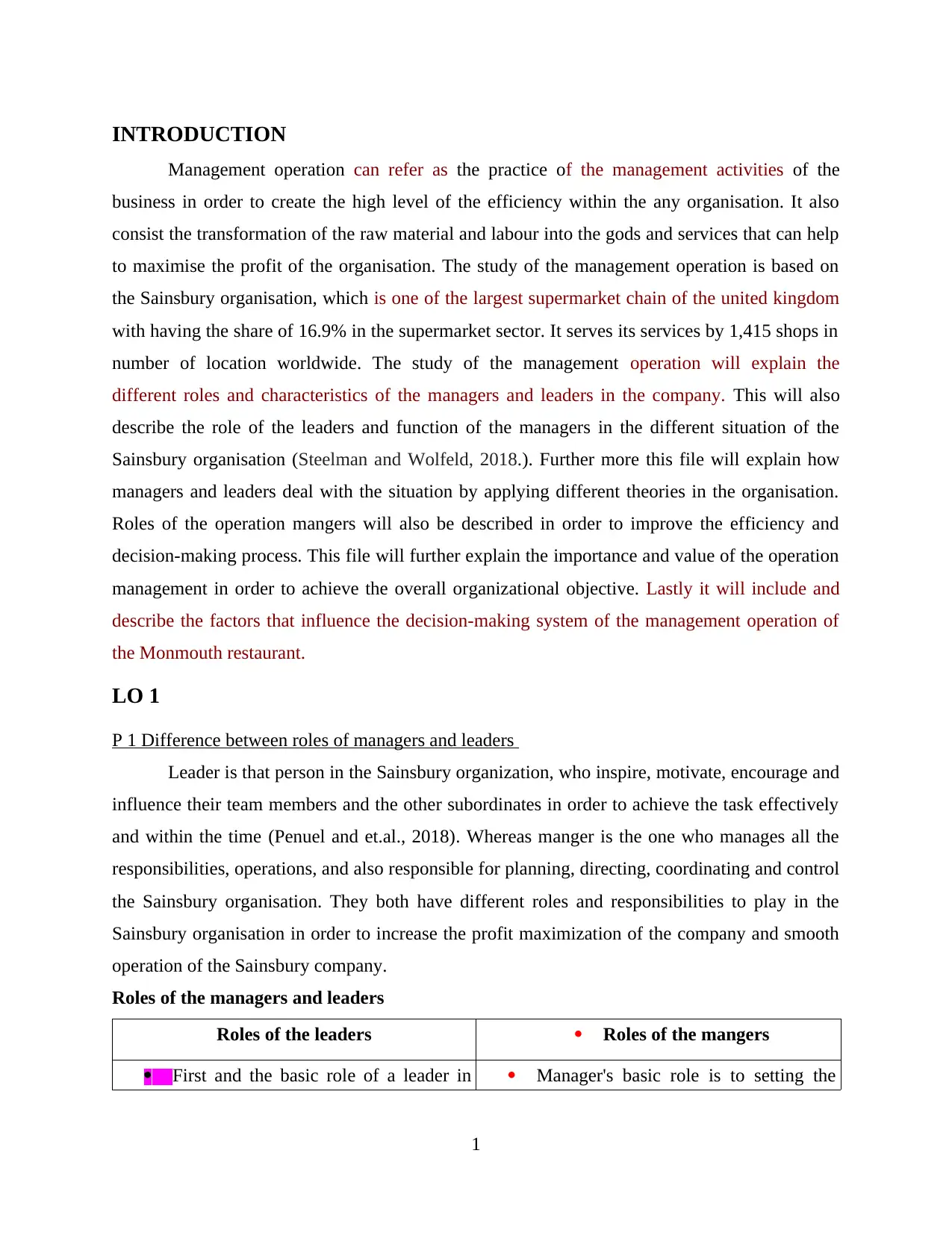
INTRODUCTION
Management operation can refer as the practice of the management activities of the
business in order to create the high level of the efficiency within the any organisation. It also
consist the transformation of the raw material and labour into the gods and services that can help
to maximise the profit of the organisation. The study of the management operation is based on
the Sainsbury organisation, which is one of the largest supermarket chain of the united kingdom
with having the share of 16.9% in the supermarket sector. It serves its services by 1,415 shops in
number of location worldwide. The study of the management operation will explain the
different roles and characteristics of the managers and leaders in the company. This will also
describe the role of the leaders and function of the managers in the different situation of the
Sainsbury organisation (Steelman and Wolfeld, 2018.). Further more this file will explain how
managers and leaders deal with the situation by applying different theories in the organisation.
Roles of the operation mangers will also be described in order to improve the efficiency and
decision-making process. This file will further explain the importance and value of the operation
management in order to achieve the overall organizational objective. Lastly it will include and
describe the factors that influence the decision-making system of the management operation of
the Monmouth restaurant.
LO 1
P 1 Difference between roles of managers and leaders
Leader is that person in the Sainsbury organization, who inspire, motivate, encourage and
influence their team members and the other subordinates in order to achieve the task effectively
and within the time (Penuel and et.al., 2018). Whereas manger is the one who manages all the
responsibilities, operations, and also responsible for planning, directing, coordinating and control
the Sainsbury organisation. They both have different roles and responsibilities to play in the
Sainsbury organisation in order to increase the profit maximization of the company and smooth
operation of the Sainsbury company.
Roles of the managers and leaders
Roles of the leaders Roles of the mangers
First and the basic role of a leader in Manager's basic role is to setting the
1
Management operation can refer as the practice of the management activities of the
business in order to create the high level of the efficiency within the any organisation. It also
consist the transformation of the raw material and labour into the gods and services that can help
to maximise the profit of the organisation. The study of the management operation is based on
the Sainsbury organisation, which is one of the largest supermarket chain of the united kingdom
with having the share of 16.9% in the supermarket sector. It serves its services by 1,415 shops in
number of location worldwide. The study of the management operation will explain the
different roles and characteristics of the managers and leaders in the company. This will also
describe the role of the leaders and function of the managers in the different situation of the
Sainsbury organisation (Steelman and Wolfeld, 2018.). Further more this file will explain how
managers and leaders deal with the situation by applying different theories in the organisation.
Roles of the operation mangers will also be described in order to improve the efficiency and
decision-making process. This file will further explain the importance and value of the operation
management in order to achieve the overall organizational objective. Lastly it will include and
describe the factors that influence the decision-making system of the management operation of
the Monmouth restaurant.
LO 1
P 1 Difference between roles of managers and leaders
Leader is that person in the Sainsbury organization, who inspire, motivate, encourage and
influence their team members and the other subordinates in order to achieve the task effectively
and within the time (Penuel and et.al., 2018). Whereas manger is the one who manages all the
responsibilities, operations, and also responsible for planning, directing, coordinating and control
the Sainsbury organisation. They both have different roles and responsibilities to play in the
Sainsbury organisation in order to increase the profit maximization of the company and smooth
operation of the Sainsbury company.
Roles of the managers and leaders
Roles of the leaders Roles of the mangers
First and the basic role of a leader in Manager's basic role is to setting the
1
⊘ This is a preview!⊘
Do you want full access?
Subscribe today to unlock all pages.

Trusted by 1+ million students worldwide
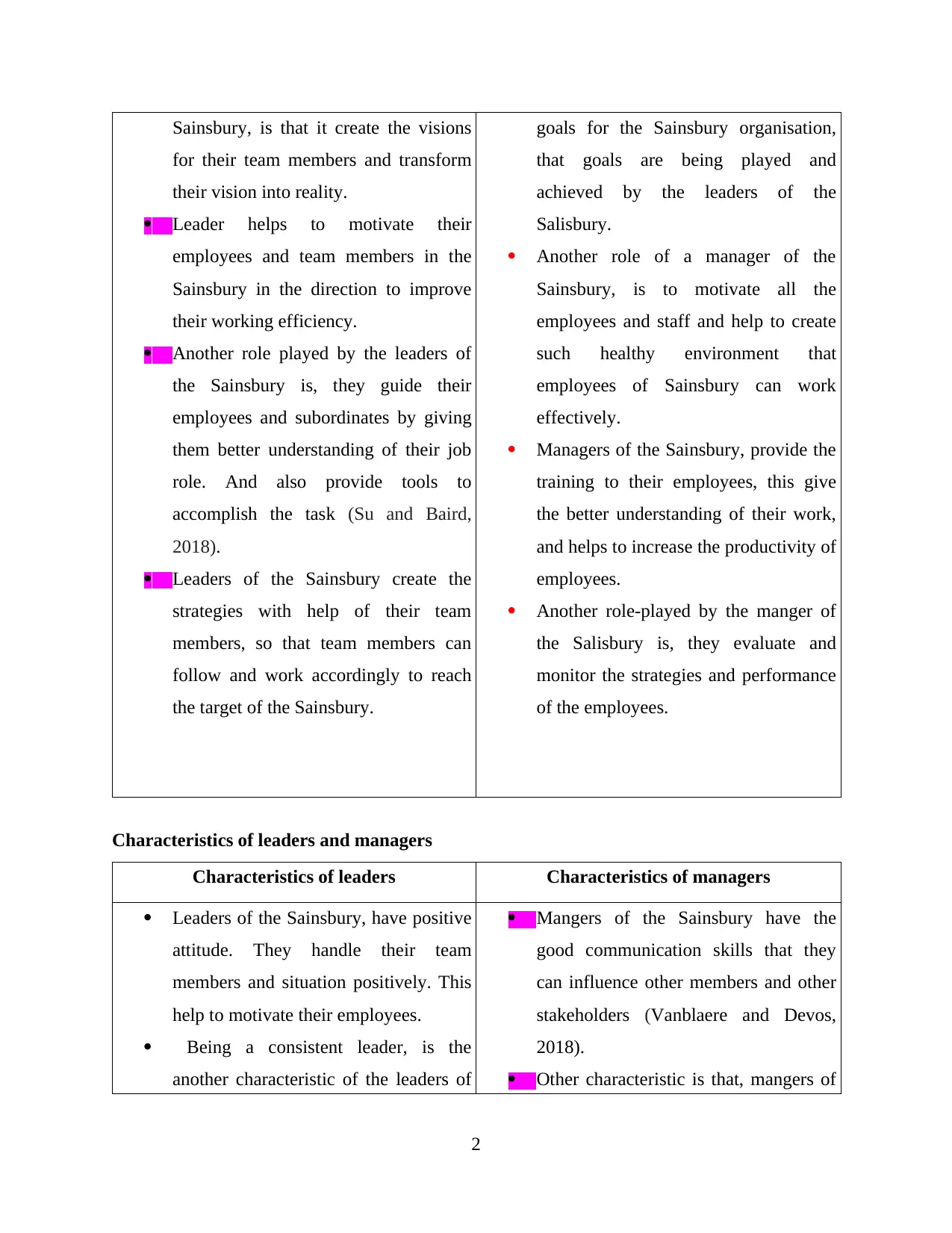
Sainsbury, is that it create the visions
for their team members and transform
their vision into reality.
Leader helps to motivate their
employees and team members in the
Sainsbury in the direction to improve
their working efficiency.
Another role played by the leaders of
the Sainsbury is, they guide their
employees and subordinates by giving
them better understanding of their job
role. And also provide tools to
accomplish the task (Su and Baird,
2018).
Leaders of the Sainsbury create the
strategies with help of their team
members, so that team members can
follow and work accordingly to reach
the target of the Sainsbury.
goals for the Sainsbury organisation,
that goals are being played and
achieved by the leaders of the
Salisbury.
Another role of a manager of the
Sainsbury, is to motivate all the
employees and staff and help to create
such healthy environment that
employees of Sainsbury can work
effectively.
Managers of the Sainsbury, provide the
training to their employees, this give
the better understanding of their work,
and helps to increase the productivity of
employees.
Another role-played by the manger of
the Salisbury is, they evaluate and
monitor the strategies and performance
of the employees.
Characteristics of leaders and managers
Characteristics of leaders Characteristics of managers
Leaders of the Sainsbury, have positive
attitude. They handle their team
members and situation positively. This
help to motivate their employees.
Being a consistent leader, is the
another characteristic of the leaders of
Mangers of the Sainsbury have the
good communication skills that they
can influence other members and other
stakeholders (Vanblaere and Devos,
2018).
Other characteristic is that, mangers of
2
for their team members and transform
their vision into reality.
Leader helps to motivate their
employees and team members in the
Sainsbury in the direction to improve
their working efficiency.
Another role played by the leaders of
the Sainsbury is, they guide their
employees and subordinates by giving
them better understanding of their job
role. And also provide tools to
accomplish the task (Su and Baird,
2018).
Leaders of the Sainsbury create the
strategies with help of their team
members, so that team members can
follow and work accordingly to reach
the target of the Sainsbury.
goals for the Sainsbury organisation,
that goals are being played and
achieved by the leaders of the
Salisbury.
Another role of a manager of the
Sainsbury, is to motivate all the
employees and staff and help to create
such healthy environment that
employees of Sainsbury can work
effectively.
Managers of the Sainsbury, provide the
training to their employees, this give
the better understanding of their work,
and helps to increase the productivity of
employees.
Another role-played by the manger of
the Salisbury is, they evaluate and
monitor the strategies and performance
of the employees.
Characteristics of leaders and managers
Characteristics of leaders Characteristics of managers
Leaders of the Sainsbury, have positive
attitude. They handle their team
members and situation positively. This
help to motivate their employees.
Being a consistent leader, is the
another characteristic of the leaders of
Mangers of the Sainsbury have the
good communication skills that they
can influence other members and other
stakeholders (Vanblaere and Devos,
2018).
Other characteristic is that, mangers of
2
Paraphrase This Document
Need a fresh take? Get an instant paraphrase of this document with our AI Paraphraser

Sainsbury. This help to setting example
in front of the their team member to be
consistence and work effectively.
Creativity is the other characteristic of
the leaders of Sainsbury. They
complete their task with creative and
innovative way.
Characteristic of the leader, is that they
have the ability to inspire, and
influence the team member to complete
the task to reach the overall objective of
the Sainsbury (Heyden, Sidhu and
Volberda, 2018).
the Sainsbury are result oriented. They
continuously motivate employees to
reach their final objective.
Another characteristic of the manger is
that they are flexible and versatile, they
can be quickly changed when necessary
and can play any role in the Sainsbury
organisation.
Manger of the Sainsbury have great
problem solving skill, this help the
Sainsbury organization to solve any
kind of the problem and remove the
barriers to reaching to the goals.
In this way mangers and leaders of Sainsbury have differences, that, managers set the
objective of the whole organization and leaders set the vision of the employees only and make
strategies only for them, managers make strategies for the whole organisation which leaders also
have t be follow.
Functions of the mangers
There are the different function of the mangers of Sainsbury, such as planning,
organizing, staffing, directing, budgeting, controlling and monitoring. These functions help the
mangers and Sainsbury to their smooth operation and also help to increase productivity of the
Sainsbury organisation.
Function of Leaders
Leaders have the different function in the Sainsbury organisation, that they have to be
perform in order to get the better result by accomplishing the task. These functions are, setting
goals, organizing team and resources to perform task, initiate action, coordinating with their team
members and etc. these functions help the leader to effectively complete task in Sainsbury
(Steelman and Wolfeld, 2018).
3
in front of the their team member to be
consistence and work effectively.
Creativity is the other characteristic of
the leaders of Sainsbury. They
complete their task with creative and
innovative way.
Characteristic of the leader, is that they
have the ability to inspire, and
influence the team member to complete
the task to reach the overall objective of
the Sainsbury (Heyden, Sidhu and
Volberda, 2018).
the Sainsbury are result oriented. They
continuously motivate employees to
reach their final objective.
Another characteristic of the manger is
that they are flexible and versatile, they
can be quickly changed when necessary
and can play any role in the Sainsbury
organisation.
Manger of the Sainsbury have great
problem solving skill, this help the
Sainsbury organization to solve any
kind of the problem and remove the
barriers to reaching to the goals.
In this way mangers and leaders of Sainsbury have differences, that, managers set the
objective of the whole organization and leaders set the vision of the employees only and make
strategies only for them, managers make strategies for the whole organisation which leaders also
have t be follow.
Functions of the mangers
There are the different function of the mangers of Sainsbury, such as planning,
organizing, staffing, directing, budgeting, controlling and monitoring. These functions help the
mangers and Sainsbury to their smooth operation and also help to increase productivity of the
Sainsbury organisation.
Function of Leaders
Leaders have the different function in the Sainsbury organisation, that they have to be
perform in order to get the better result by accomplishing the task. These functions are, setting
goals, organizing team and resources to perform task, initiate action, coordinating with their team
members and etc. these functions help the leader to effectively complete task in Sainsbury
(Steelman and Wolfeld, 2018).
3
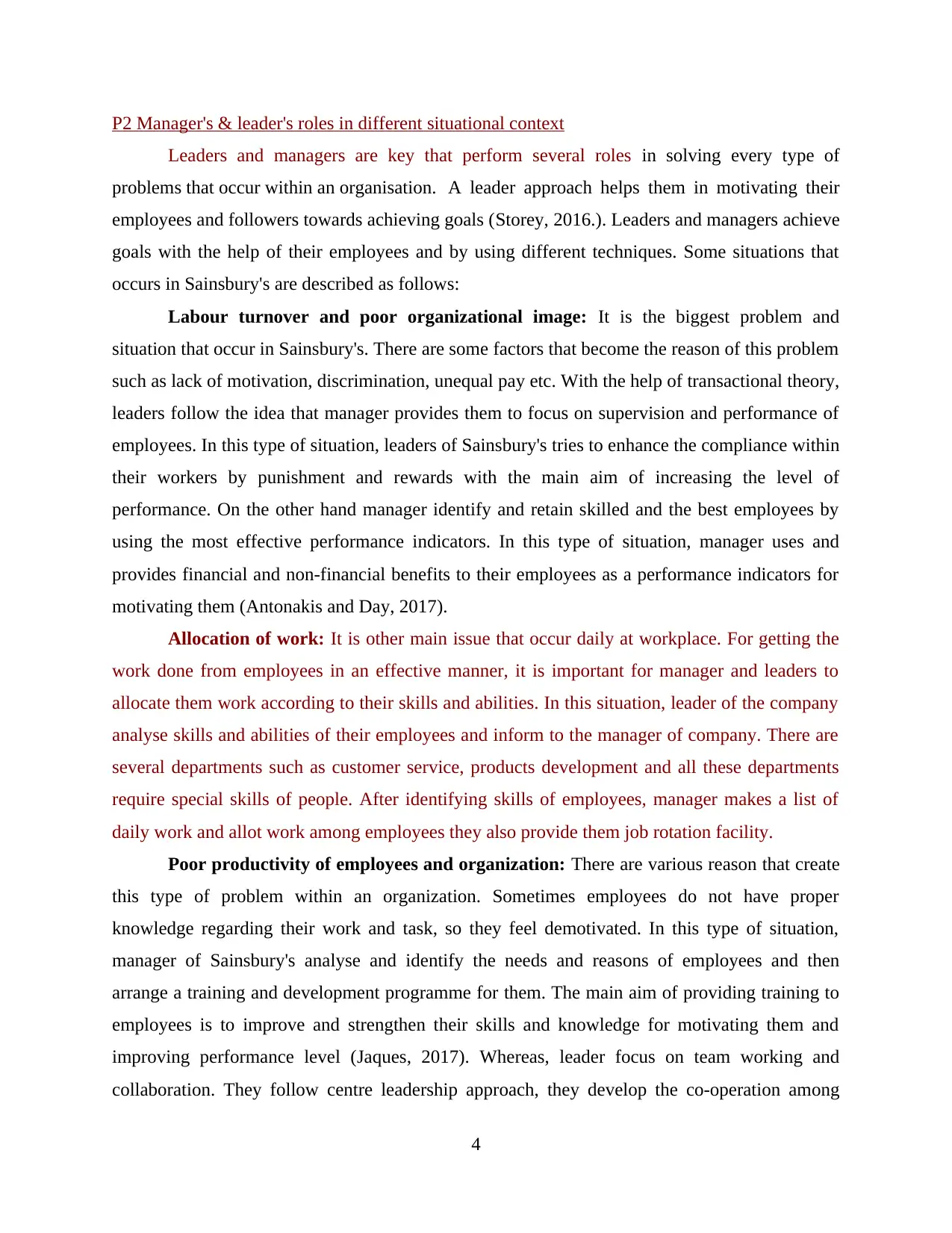
P2 Manager's & leader's roles in different situational context
Leaders and managers are key that perform several roles in solving every type of
problems that occur within an organisation. A leader approach helps them in motivating their
employees and followers towards achieving goals (Storey, 2016.). Leaders and managers achieve
goals with the help of their employees and by using different techniques. Some situations that
occurs in Sainsbury's are described as follows:
Labour turnover and poor organizational image: It is the biggest problem and
situation that occur in Sainsbury's. There are some factors that become the reason of this problem
such as lack of motivation, discrimination, unequal pay etc. With the help of transactional theory,
leaders follow the idea that manager provides them to focus on supervision and performance of
employees. In this type of situation, leaders of Sainsbury's tries to enhance the compliance within
their workers by punishment and rewards with the main aim of increasing the level of
performance. On the other hand manager identify and retain skilled and the best employees by
using the most effective performance indicators. In this type of situation, manager uses and
provides financial and non-financial benefits to their employees as a performance indicators for
motivating them (Antonakis and Day, 2017).
Allocation of work: It is other main issue that occur daily at workplace. For getting the
work done from employees in an effective manner, it is important for manager and leaders to
allocate them work according to their skills and abilities. In this situation, leader of the company
analyse skills and abilities of their employees and inform to the manager of company. There are
several departments such as customer service, products development and all these departments
require special skills of people. After identifying skills of employees, manager makes a list of
daily work and allot work among employees they also provide them job rotation facility.
Poor productivity of employees and organization: There are various reason that create
this type of problem within an organization. Sometimes employees do not have proper
knowledge regarding their work and task, so they feel demotivated. In this type of situation,
manager of Sainsbury's analyse and identify the needs and reasons of employees and then
arrange a training and development programme for them. The main aim of providing training to
employees is to improve and strengthen their skills and knowledge for motivating them and
improving performance level (Jaques, 2017). Whereas, leader focus on team working and
collaboration. They follow centre leadership approach, they develop the co-operation among
4
Leaders and managers are key that perform several roles in solving every type of
problems that occur within an organisation. A leader approach helps them in motivating their
employees and followers towards achieving goals (Storey, 2016.). Leaders and managers achieve
goals with the help of their employees and by using different techniques. Some situations that
occurs in Sainsbury's are described as follows:
Labour turnover and poor organizational image: It is the biggest problem and
situation that occur in Sainsbury's. There are some factors that become the reason of this problem
such as lack of motivation, discrimination, unequal pay etc. With the help of transactional theory,
leaders follow the idea that manager provides them to focus on supervision and performance of
employees. In this type of situation, leaders of Sainsbury's tries to enhance the compliance within
their workers by punishment and rewards with the main aim of increasing the level of
performance. On the other hand manager identify and retain skilled and the best employees by
using the most effective performance indicators. In this type of situation, manager uses and
provides financial and non-financial benefits to their employees as a performance indicators for
motivating them (Antonakis and Day, 2017).
Allocation of work: It is other main issue that occur daily at workplace. For getting the
work done from employees in an effective manner, it is important for manager and leaders to
allocate them work according to their skills and abilities. In this situation, leader of the company
analyse skills and abilities of their employees and inform to the manager of company. There are
several departments such as customer service, products development and all these departments
require special skills of people. After identifying skills of employees, manager makes a list of
daily work and allot work among employees they also provide them job rotation facility.
Poor productivity of employees and organization: There are various reason that create
this type of problem within an organization. Sometimes employees do not have proper
knowledge regarding their work and task, so they feel demotivated. In this type of situation,
manager of Sainsbury's analyse and identify the needs and reasons of employees and then
arrange a training and development programme for them. The main aim of providing training to
employees is to improve and strengthen their skills and knowledge for motivating them and
improving performance level (Jaques, 2017). Whereas, leader focus on team working and
collaboration. They follow centre leadership approach, they develop the co-operation among
4
⊘ This is a preview!⊘
Do you want full access?
Subscribe today to unlock all pages.

Trusted by 1+ million students worldwide
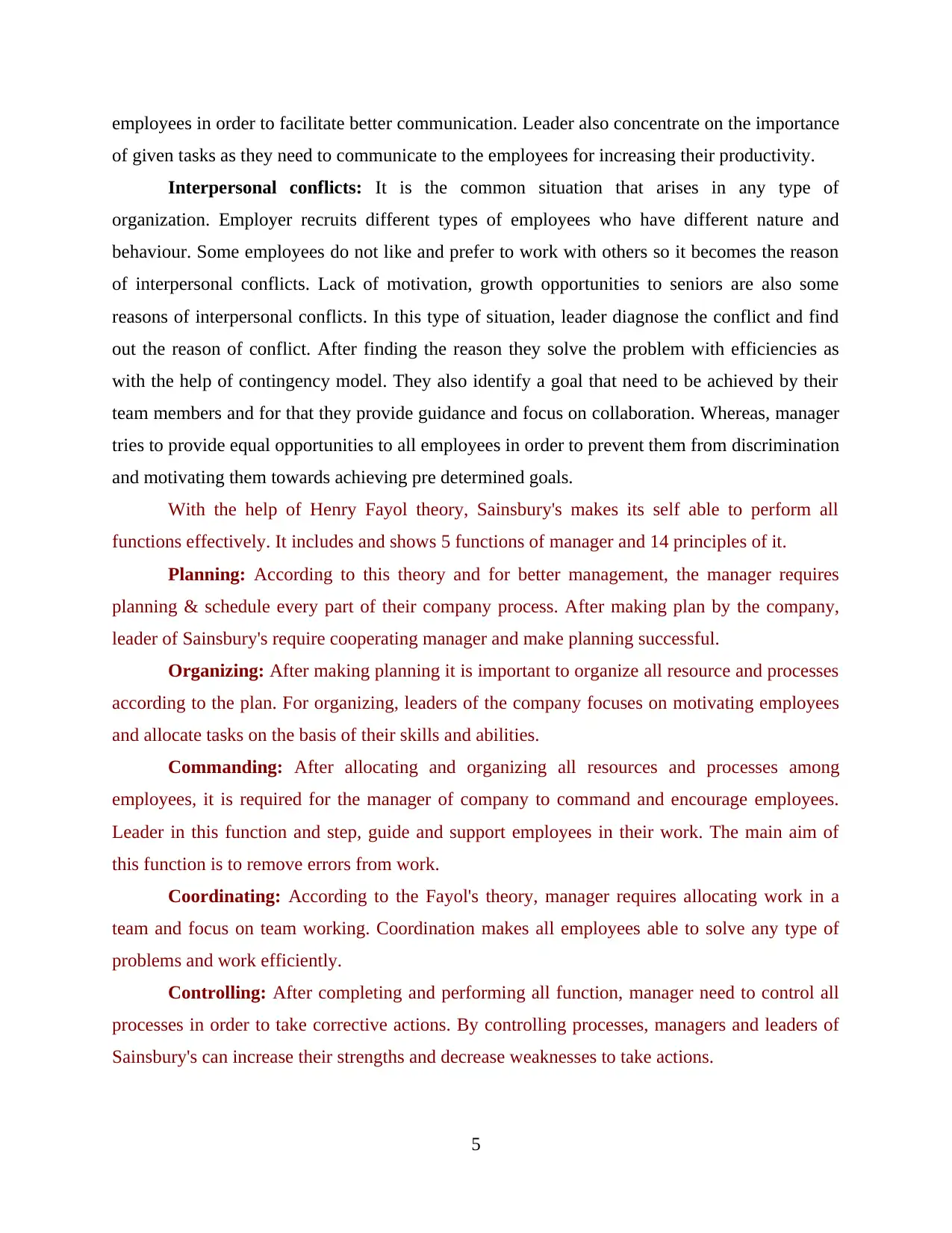
employees in order to facilitate better communication. Leader also concentrate on the importance
of given tasks as they need to communicate to the employees for increasing their productivity.
Interpersonal conflicts: It is the common situation that arises in any type of
organization. Employer recruits different types of employees who have different nature and
behaviour. Some employees do not like and prefer to work with others so it becomes the reason
of interpersonal conflicts. Lack of motivation, growth opportunities to seniors are also some
reasons of interpersonal conflicts. In this type of situation, leader diagnose the conflict and find
out the reason of conflict. After finding the reason they solve the problem with efficiencies as
with the help of contingency model. They also identify a goal that need to be achieved by their
team members and for that they provide guidance and focus on collaboration. Whereas, manager
tries to provide equal opportunities to all employees in order to prevent them from discrimination
and motivating them towards achieving pre determined goals.
With the help of Henry Fayol theory, Sainsbury's makes its self able to perform all
functions effectively. It includes and shows 5 functions of manager and 14 principles of it.
Planning: According to this theory and for better management, the manager requires
planning & schedule every part of their company process. After making plan by the company,
leader of Sainsbury's require cooperating manager and make planning successful.
Organizing: After making planning it is important to organize all resource and processes
according to the plan. For organizing, leaders of the company focuses on motivating employees
and allocate tasks on the basis of their skills and abilities.
Commanding: After allocating and organizing all resources and processes among
employees, it is required for the manager of company to command and encourage employees.
Leader in this function and step, guide and support employees in their work. The main aim of
this function is to remove errors from work.
Coordinating: According to the Fayol's theory, manager requires allocating work in a
team and focus on team working. Coordination makes all employees able to solve any type of
problems and work efficiently.
Controlling: After completing and performing all function, manager need to control all
processes in order to take corrective actions. By controlling processes, managers and leaders of
Sainsbury's can increase their strengths and decrease weaknesses to take actions.
5
of given tasks as they need to communicate to the employees for increasing their productivity.
Interpersonal conflicts: It is the common situation that arises in any type of
organization. Employer recruits different types of employees who have different nature and
behaviour. Some employees do not like and prefer to work with others so it becomes the reason
of interpersonal conflicts. Lack of motivation, growth opportunities to seniors are also some
reasons of interpersonal conflicts. In this type of situation, leader diagnose the conflict and find
out the reason of conflict. After finding the reason they solve the problem with efficiencies as
with the help of contingency model. They also identify a goal that need to be achieved by their
team members and for that they provide guidance and focus on collaboration. Whereas, manager
tries to provide equal opportunities to all employees in order to prevent them from discrimination
and motivating them towards achieving pre determined goals.
With the help of Henry Fayol theory, Sainsbury's makes its self able to perform all
functions effectively. It includes and shows 5 functions of manager and 14 principles of it.
Planning: According to this theory and for better management, the manager requires
planning & schedule every part of their company process. After making plan by the company,
leader of Sainsbury's require cooperating manager and make planning successful.
Organizing: After making planning it is important to organize all resource and processes
according to the plan. For organizing, leaders of the company focuses on motivating employees
and allocate tasks on the basis of their skills and abilities.
Commanding: After allocating and organizing all resources and processes among
employees, it is required for the manager of company to command and encourage employees.
Leader in this function and step, guide and support employees in their work. The main aim of
this function is to remove errors from work.
Coordinating: According to the Fayol's theory, manager requires allocating work in a
team and focus on team working. Coordination makes all employees able to solve any type of
problems and work efficiently.
Controlling: After completing and performing all function, manager need to control all
processes in order to take corrective actions. By controlling processes, managers and leaders of
Sainsbury's can increase their strengths and decrease weaknesses to take actions.
5
Paraphrase This Document
Need a fresh take? Get an instant paraphrase of this document with our AI Paraphraser
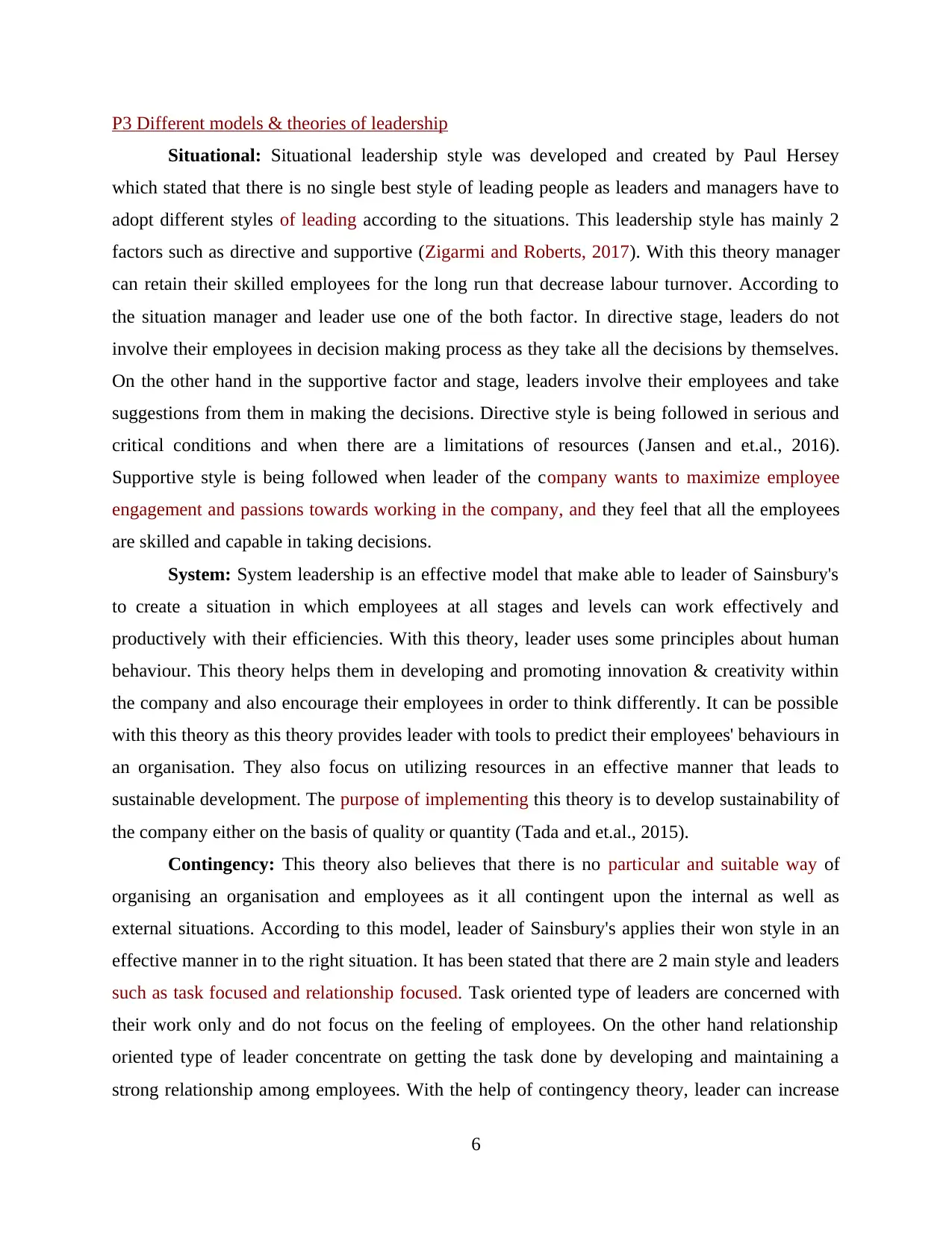
P3 Different models & theories of leadership
Situational: Situational leadership style was developed and created by Paul Hersey
which stated that there is no single best style of leading people as leaders and managers have to
adopt different styles of leading according to the situations. This leadership style has mainly 2
factors such as directive and supportive (Zigarmi and Roberts, 2017). With this theory manager
can retain their skilled employees for the long run that decrease labour turnover. According to
the situation manager and leader use one of the both factor. In directive stage, leaders do not
involve their employees in decision making process as they take all the decisions by themselves.
On the other hand in the supportive factor and stage, leaders involve their employees and take
suggestions from them in making the decisions. Directive style is being followed in serious and
critical conditions and when there are a limitations of resources (Jansen and et.al., 2016).
Supportive style is being followed when leader of the company wants to maximize employee
engagement and passions towards working in the company, and they feel that all the employees
are skilled and capable in taking decisions.
System: System leadership is an effective model that make able to leader of Sainsbury's
to create a situation in which employees at all stages and levels can work effectively and
productively with their efficiencies. With this theory, leader uses some principles about human
behaviour. This theory helps them in developing and promoting innovation & creativity within
the company and also encourage their employees in order to think differently. It can be possible
with this theory as this theory provides leader with tools to predict their employees' behaviours in
an organisation. They also focus on utilizing resources in an effective manner that leads to
sustainable development. The purpose of implementing this theory is to develop sustainability of
the company either on the basis of quality or quantity (Tada and et.al., 2015).
Contingency: This theory also believes that there is no particular and suitable way of
organising an organisation and employees as it all contingent upon the internal as well as
external situations. According to this model, leader of Sainsbury's applies their won style in an
effective manner in to the right situation. It has been stated that there are 2 main style and leaders
such as task focused and relationship focused. Task oriented type of leaders are concerned with
their work only and do not focus on the feeling of employees. On the other hand relationship
oriented type of leader concentrate on getting the task done by developing and maintaining a
strong relationship among employees. With the help of contingency theory, leader can increase
6
Situational: Situational leadership style was developed and created by Paul Hersey
which stated that there is no single best style of leading people as leaders and managers have to
adopt different styles of leading according to the situations. This leadership style has mainly 2
factors such as directive and supportive (Zigarmi and Roberts, 2017). With this theory manager
can retain their skilled employees for the long run that decrease labour turnover. According to
the situation manager and leader use one of the both factor. In directive stage, leaders do not
involve their employees in decision making process as they take all the decisions by themselves.
On the other hand in the supportive factor and stage, leaders involve their employees and take
suggestions from them in making the decisions. Directive style is being followed in serious and
critical conditions and when there are a limitations of resources (Jansen and et.al., 2016).
Supportive style is being followed when leader of the company wants to maximize employee
engagement and passions towards working in the company, and they feel that all the employees
are skilled and capable in taking decisions.
System: System leadership is an effective model that make able to leader of Sainsbury's
to create a situation in which employees at all stages and levels can work effectively and
productively with their efficiencies. With this theory, leader uses some principles about human
behaviour. This theory helps them in developing and promoting innovation & creativity within
the company and also encourage their employees in order to think differently. It can be possible
with this theory as this theory provides leader with tools to predict their employees' behaviours in
an organisation. They also focus on utilizing resources in an effective manner that leads to
sustainable development. The purpose of implementing this theory is to develop sustainability of
the company either on the basis of quality or quantity (Tada and et.al., 2015).
Contingency: This theory also believes that there is no particular and suitable way of
organising an organisation and employees as it all contingent upon the internal as well as
external situations. According to this model, leader of Sainsbury's applies their won style in an
effective manner in to the right situation. It has been stated that there are 2 main style and leaders
such as task focused and relationship focused. Task oriented type of leaders are concerned with
their work only and do not focus on the feeling of employees. On the other hand relationship
oriented type of leader concentrate on getting the task done by developing and maintaining a
strong relationship among employees. With the help of contingency theory, leader can increase
6
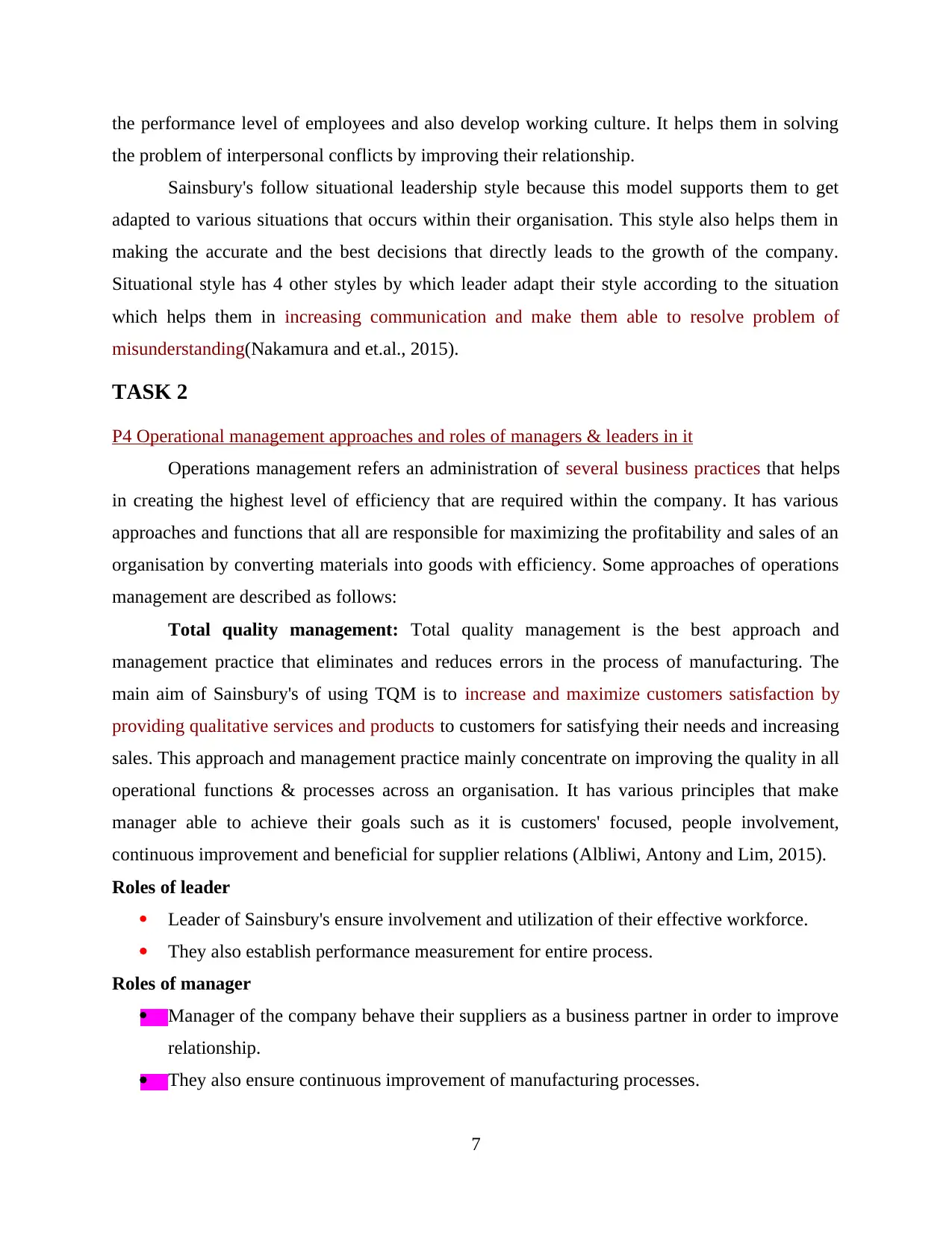
the performance level of employees and also develop working culture. It helps them in solving
the problem of interpersonal conflicts by improving their relationship.
Sainsbury's follow situational leadership style because this model supports them to get
adapted to various situations that occurs within their organisation. This style also helps them in
making the accurate and the best decisions that directly leads to the growth of the company.
Situational style has 4 other styles by which leader adapt their style according to the situation
which helps them in increasing communication and make them able to resolve problem of
misunderstanding(Nakamura and et.al., 2015).
TASK 2
P4 Operational management approaches and roles of managers & leaders in it
Operations management refers an administration of several business practices that helps
in creating the highest level of efficiency that are required within the company. It has various
approaches and functions that all are responsible for maximizing the profitability and sales of an
organisation by converting materials into goods with efficiency. Some approaches of operations
management are described as follows:
Total quality management: Total quality management is the best approach and
management practice that eliminates and reduces errors in the process of manufacturing. The
main aim of Sainsbury's of using TQM is to increase and maximize customers satisfaction by
providing qualitative services and products to customers for satisfying their needs and increasing
sales. This approach and management practice mainly concentrate on improving the quality in all
operational functions & processes across an organisation. It has various principles that make
manager able to achieve their goals such as it is customers' focused, people involvement,
continuous improvement and beneficial for supplier relations (Albliwi, Antony and Lim, 2015).
Roles of leader
Leader of Sainsbury's ensure involvement and utilization of their effective workforce.
They also establish performance measurement for entire process.
Roles of manager
Manager of the company behave their suppliers as a business partner in order to improve
relationship.
They also ensure continuous improvement of manufacturing processes.
7
the problem of interpersonal conflicts by improving their relationship.
Sainsbury's follow situational leadership style because this model supports them to get
adapted to various situations that occurs within their organisation. This style also helps them in
making the accurate and the best decisions that directly leads to the growth of the company.
Situational style has 4 other styles by which leader adapt their style according to the situation
which helps them in increasing communication and make them able to resolve problem of
misunderstanding(Nakamura and et.al., 2015).
TASK 2
P4 Operational management approaches and roles of managers & leaders in it
Operations management refers an administration of several business practices that helps
in creating the highest level of efficiency that are required within the company. It has various
approaches and functions that all are responsible for maximizing the profitability and sales of an
organisation by converting materials into goods with efficiency. Some approaches of operations
management are described as follows:
Total quality management: Total quality management is the best approach and
management practice that eliminates and reduces errors in the process of manufacturing. The
main aim of Sainsbury's of using TQM is to increase and maximize customers satisfaction by
providing qualitative services and products to customers for satisfying their needs and increasing
sales. This approach and management practice mainly concentrate on improving the quality in all
operational functions & processes across an organisation. It has various principles that make
manager able to achieve their goals such as it is customers' focused, people involvement,
continuous improvement and beneficial for supplier relations (Albliwi, Antony and Lim, 2015).
Roles of leader
Leader of Sainsbury's ensure involvement and utilization of their effective workforce.
They also establish performance measurement for entire process.
Roles of manager
Manager of the company behave their suppliers as a business partner in order to improve
relationship.
They also ensure continuous improvement of manufacturing processes.
7
⊘ This is a preview!⊘
Do you want full access?
Subscribe today to unlock all pages.

Trusted by 1+ million students worldwide
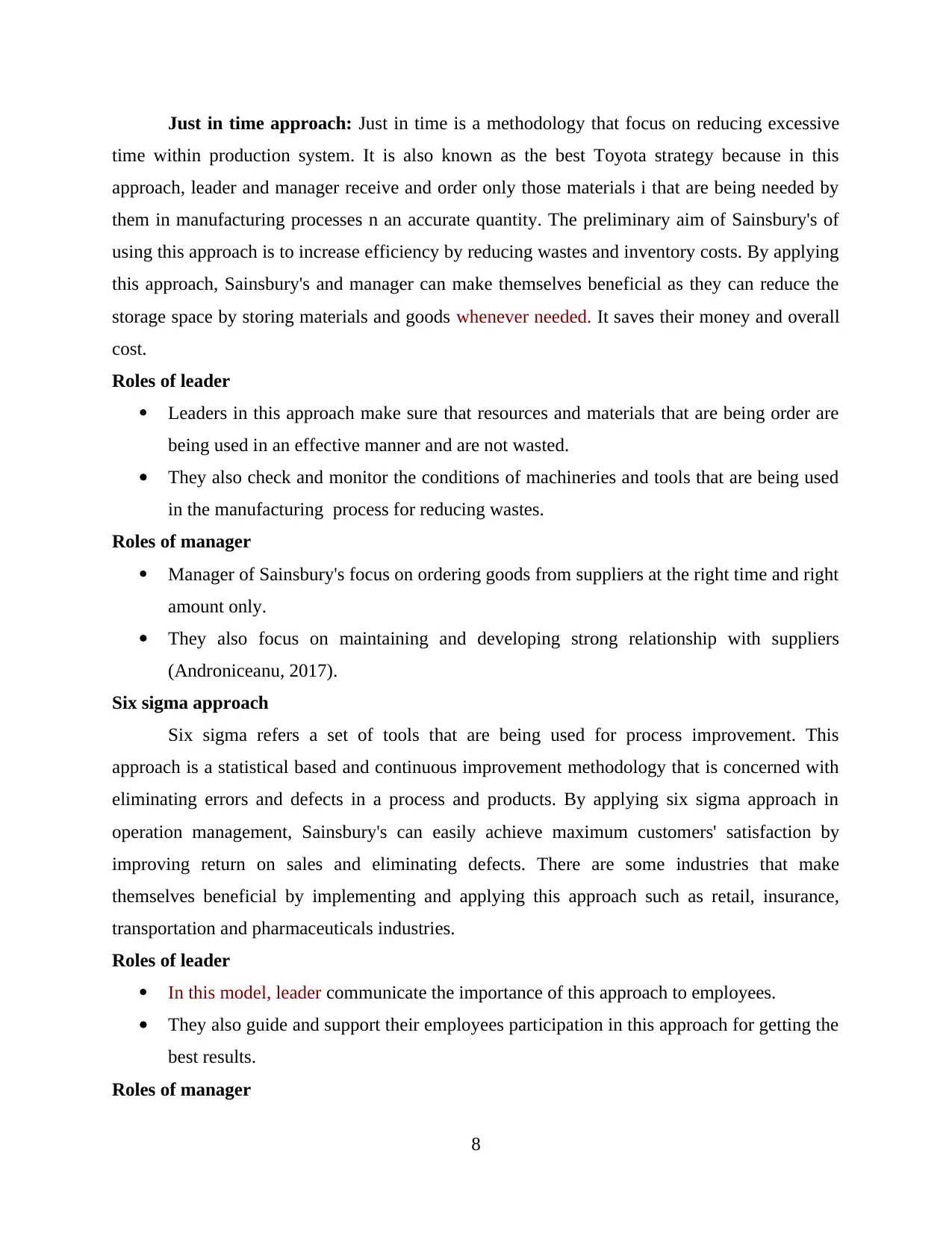
Just in time approach: Just in time is a methodology that focus on reducing excessive
time within production system. It is also known as the best Toyota strategy because in this
approach, leader and manager receive and order only those materials i that are being needed by
them in manufacturing processes n an accurate quantity. The preliminary aim of Sainsbury's of
using this approach is to increase efficiency by reducing wastes and inventory costs. By applying
this approach, Sainsbury's and manager can make themselves beneficial as they can reduce the
storage space by storing materials and goods whenever needed. It saves their money and overall
cost.
Roles of leader
Leaders in this approach make sure that resources and materials that are being order are
being used in an effective manner and are not wasted.
They also check and monitor the conditions of machineries and tools that are being used
in the manufacturing process for reducing wastes.
Roles of manager
Manager of Sainsbury's focus on ordering goods from suppliers at the right time and right
amount only.
They also focus on maintaining and developing strong relationship with suppliers
(Androniceanu, 2017).
Six sigma approach
Six sigma refers a set of tools that are being used for process improvement. This
approach is a statistical based and continuous improvement methodology that is concerned with
eliminating errors and defects in a process and products. By applying six sigma approach in
operation management, Sainsbury's can easily achieve maximum customers' satisfaction by
improving return on sales and eliminating defects. There are some industries that make
themselves beneficial by implementing and applying this approach such as retail, insurance,
transportation and pharmaceuticals industries.
Roles of leader
In this model, leader communicate the importance of this approach to employees.
They also guide and support their employees participation in this approach for getting the
best results.
Roles of manager
8
time within production system. It is also known as the best Toyota strategy because in this
approach, leader and manager receive and order only those materials i that are being needed by
them in manufacturing processes n an accurate quantity. The preliminary aim of Sainsbury's of
using this approach is to increase efficiency by reducing wastes and inventory costs. By applying
this approach, Sainsbury's and manager can make themselves beneficial as they can reduce the
storage space by storing materials and goods whenever needed. It saves their money and overall
cost.
Roles of leader
Leaders in this approach make sure that resources and materials that are being order are
being used in an effective manner and are not wasted.
They also check and monitor the conditions of machineries and tools that are being used
in the manufacturing process for reducing wastes.
Roles of manager
Manager of Sainsbury's focus on ordering goods from suppliers at the right time and right
amount only.
They also focus on maintaining and developing strong relationship with suppliers
(Androniceanu, 2017).
Six sigma approach
Six sigma refers a set of tools that are being used for process improvement. This
approach is a statistical based and continuous improvement methodology that is concerned with
eliminating errors and defects in a process and products. By applying six sigma approach in
operation management, Sainsbury's can easily achieve maximum customers' satisfaction by
improving return on sales and eliminating defects. There are some industries that make
themselves beneficial by implementing and applying this approach such as retail, insurance,
transportation and pharmaceuticals industries.
Roles of leader
In this model, leader communicate the importance of this approach to employees.
They also guide and support their employees participation in this approach for getting the
best results.
Roles of manager
8
Paraphrase This Document
Need a fresh take? Get an instant paraphrase of this document with our AI Paraphraser
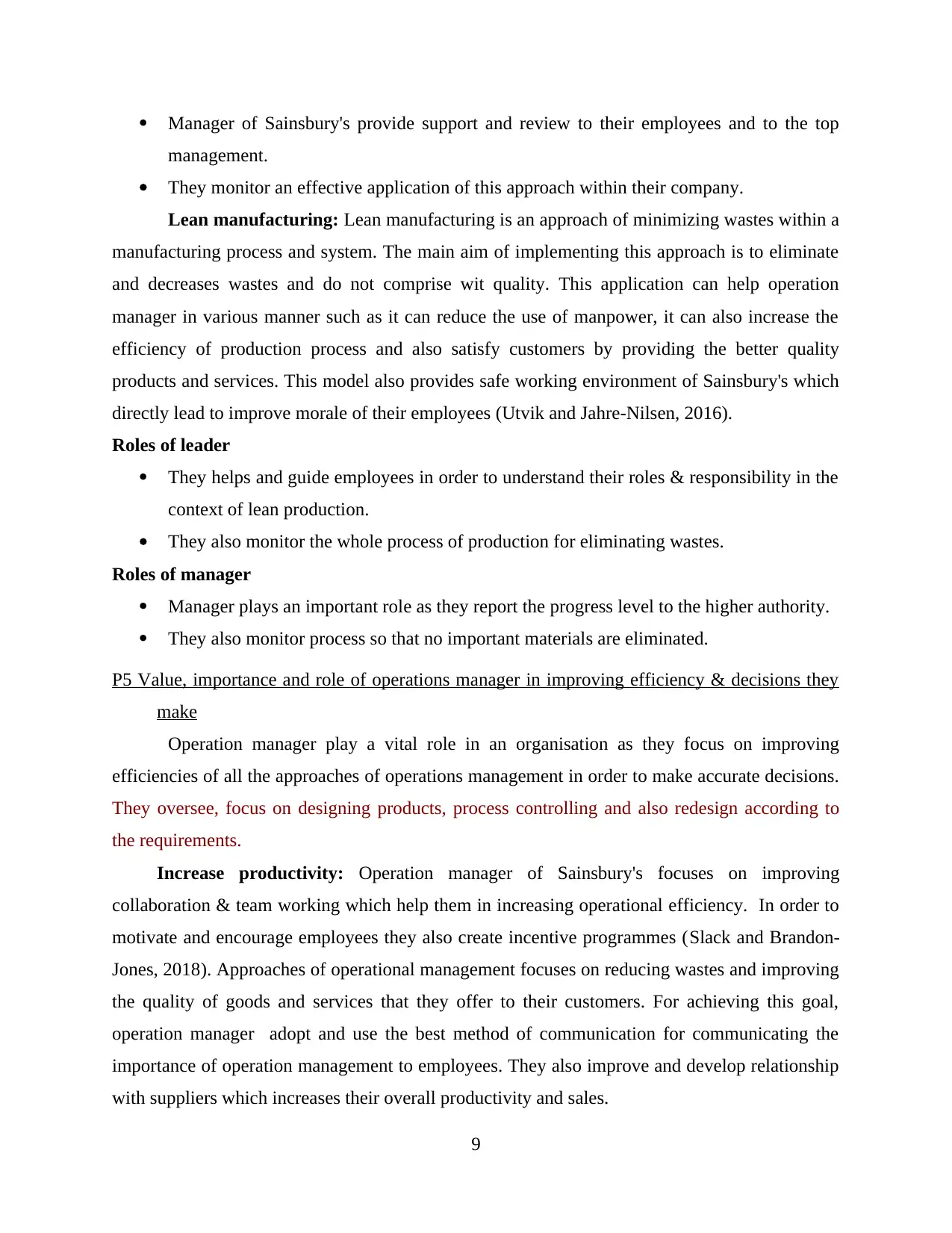
Manager of Sainsbury's provide support and review to their employees and to the top
management.
They monitor an effective application of this approach within their company.
Lean manufacturing: Lean manufacturing is an approach of minimizing wastes within a
manufacturing process and system. The main aim of implementing this approach is to eliminate
and decreases wastes and do not comprise wit quality. This application can help operation
manager in various manner such as it can reduce the use of manpower, it can also increase the
efficiency of production process and also satisfy customers by providing the better quality
products and services. This model also provides safe working environment of Sainsbury's which
directly lead to improve morale of their employees (Utvik and Jahre-Nilsen, 2016).
Roles of leader
They helps and guide employees in order to understand their roles & responsibility in the
context of lean production.
They also monitor the whole process of production for eliminating wastes.
Roles of manager
Manager plays an important role as they report the progress level to the higher authority.
They also monitor process so that no important materials are eliminated.
P5 Value, importance and role of operations manager in improving efficiency & decisions they
make
Operation manager play a vital role in an organisation as they focus on improving
efficiencies of all the approaches of operations management in order to make accurate decisions.
They oversee, focus on designing products, process controlling and also redesign according to
the requirements.
Increase productivity: Operation manager of Sainsbury's focuses on improving
collaboration & team working which help them in increasing operational efficiency. In order to
motivate and encourage employees they also create incentive programmes (Slack and Brandon-
Jones, 2018). Approaches of operational management focuses on reducing wastes and improving
the quality of goods and services that they offer to their customers. For achieving this goal,
operation manager adopt and use the best method of communication for communicating the
importance of operation management to employees. They also improve and develop relationship
with suppliers which increases their overall productivity and sales.
9
management.
They monitor an effective application of this approach within their company.
Lean manufacturing: Lean manufacturing is an approach of minimizing wastes within a
manufacturing process and system. The main aim of implementing this approach is to eliminate
and decreases wastes and do not comprise wit quality. This application can help operation
manager in various manner such as it can reduce the use of manpower, it can also increase the
efficiency of production process and also satisfy customers by providing the better quality
products and services. This model also provides safe working environment of Sainsbury's which
directly lead to improve morale of their employees (Utvik and Jahre-Nilsen, 2016).
Roles of leader
They helps and guide employees in order to understand their roles & responsibility in the
context of lean production.
They also monitor the whole process of production for eliminating wastes.
Roles of manager
Manager plays an important role as they report the progress level to the higher authority.
They also monitor process so that no important materials are eliminated.
P5 Value, importance and role of operations manager in improving efficiency & decisions they
make
Operation manager play a vital role in an organisation as they focus on improving
efficiencies of all the approaches of operations management in order to make accurate decisions.
They oversee, focus on designing products, process controlling and also redesign according to
the requirements.
Increase productivity: Operation manager of Sainsbury's focuses on improving
collaboration & team working which help them in increasing operational efficiency. In order to
motivate and encourage employees they also create incentive programmes (Slack and Brandon-
Jones, 2018). Approaches of operational management focuses on reducing wastes and improving
the quality of goods and services that they offer to their customers. For achieving this goal,
operation manager adopt and use the best method of communication for communicating the
importance of operation management to employees. They also improve and develop relationship
with suppliers which increases their overall productivity and sales.
9
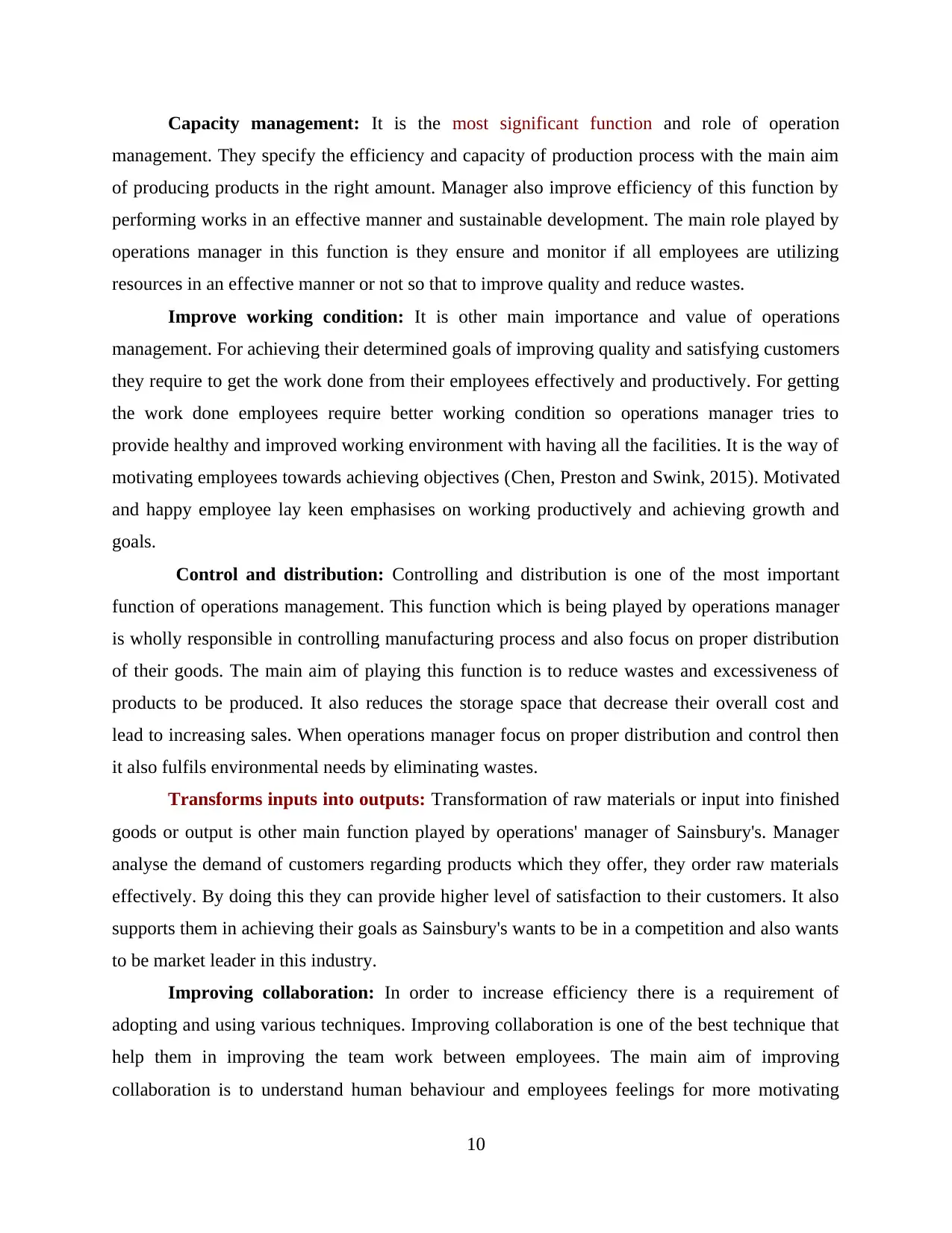
Capacity management: It is the most significant function and role of operation
management. They specify the efficiency and capacity of production process with the main aim
of producing products in the right amount. Manager also improve efficiency of this function by
performing works in an effective manner and sustainable development. The main role played by
operations manager in this function is they ensure and monitor if all employees are utilizing
resources in an effective manner or not so that to improve quality and reduce wastes.
Improve working condition: It is other main importance and value of operations
management. For achieving their determined goals of improving quality and satisfying customers
they require to get the work done from their employees effectively and productively. For getting
the work done employees require better working condition so operations manager tries to
provide healthy and improved working environment with having all the facilities. It is the way of
motivating employees towards achieving objectives (Chen, Preston and Swink, 2015). Motivated
and happy employee lay keen emphasises on working productively and achieving growth and
goals.
Control and distribution: Controlling and distribution is one of the most important
function of operations management. This function which is being played by operations manager
is wholly responsible in controlling manufacturing process and also focus on proper distribution
of their goods. The main aim of playing this function is to reduce wastes and excessiveness of
products to be produced. It also reduces the storage space that decrease their overall cost and
lead to increasing sales. When operations manager focus on proper distribution and control then
it also fulfils environmental needs by eliminating wastes.
Transforms inputs into outputs: Transformation of raw materials or input into finished
goods or output is other main function played by operations' manager of Sainsbury's. Manager
analyse the demand of customers regarding products which they offer, they order raw materials
effectively. By doing this they can provide higher level of satisfaction to their customers. It also
supports them in achieving their goals as Sainsbury's wants to be in a competition and also wants
to be market leader in this industry.
Improving collaboration: In order to increase efficiency there is a requirement of
adopting and using various techniques. Improving collaboration is one of the best technique that
help them in improving the team work between employees. The main aim of improving
collaboration is to understand human behaviour and employees feelings for more motivating
10
management. They specify the efficiency and capacity of production process with the main aim
of producing products in the right amount. Manager also improve efficiency of this function by
performing works in an effective manner and sustainable development. The main role played by
operations manager in this function is they ensure and monitor if all employees are utilizing
resources in an effective manner or not so that to improve quality and reduce wastes.
Improve working condition: It is other main importance and value of operations
management. For achieving their determined goals of improving quality and satisfying customers
they require to get the work done from their employees effectively and productively. For getting
the work done employees require better working condition so operations manager tries to
provide healthy and improved working environment with having all the facilities. It is the way of
motivating employees towards achieving objectives (Chen, Preston and Swink, 2015). Motivated
and happy employee lay keen emphasises on working productively and achieving growth and
goals.
Control and distribution: Controlling and distribution is one of the most important
function of operations management. This function which is being played by operations manager
is wholly responsible in controlling manufacturing process and also focus on proper distribution
of their goods. The main aim of playing this function is to reduce wastes and excessiveness of
products to be produced. It also reduces the storage space that decrease their overall cost and
lead to increasing sales. When operations manager focus on proper distribution and control then
it also fulfils environmental needs by eliminating wastes.
Transforms inputs into outputs: Transformation of raw materials or input into finished
goods or output is other main function played by operations' manager of Sainsbury's. Manager
analyse the demand of customers regarding products which they offer, they order raw materials
effectively. By doing this they can provide higher level of satisfaction to their customers. It also
supports them in achieving their goals as Sainsbury's wants to be in a competition and also wants
to be market leader in this industry.
Improving collaboration: In order to increase efficiency there is a requirement of
adopting and using various techniques. Improving collaboration is one of the best technique that
help them in improving the team work between employees. The main aim of improving
collaboration is to understand human behaviour and employees feelings for more motivating
10
⊘ This is a preview!⊘
Do you want full access?
Subscribe today to unlock all pages.

Trusted by 1+ million students worldwide
1 out of 17
Related Documents
Your All-in-One AI-Powered Toolkit for Academic Success.
+13062052269
info@desklib.com
Available 24*7 on WhatsApp / Email
![[object Object]](/_next/static/media/star-bottom.7253800d.svg)
Unlock your academic potential
Copyright © 2020–2025 A2Z Services. All Rights Reserved. Developed and managed by ZUCOL.





